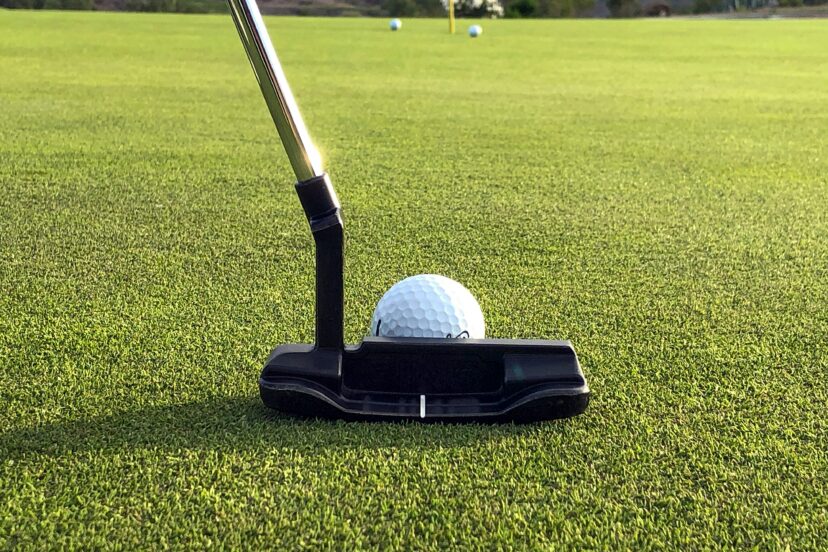How To Improve Your Putting
Have you ever walked off the green after a frustrating three-putt and thought, “That’s where my round fell apart”? You’re not alone. As both a player and someone who’s spent countless hours trying to improve my putting, I can tell you that putting is often where the greatest number of strokes can be saved—or lost. Many amateur golfers spend hours at the driving range working on their long game but neglect the aspect of golf that typically accounts for 40% or more of their total strokes. My point here is that a stroke is a stroke is a stroke- doesn’t matter if you hit if 600 yards or 6 inches.

Understanding the Basics of Putting
Before we dive into advanced techniques and strategies, it’s essential to ensure you have the fundamentals down. Even the most sophisticated putting strategies won’t help if your basic technique is flawed.
Proper Grip and Stance
The way you hold your putter significantly impacts your ability to make a smooth, consistent stroke. While there are several acceptable putting grips—conventional, cross-handed, claw, or prayer—the most important thing is finding one that feels comfortable and produces consistent results for you. By the way- and this is just a personal thing with me- I HATE those big “gate swing” putter things… I don’t even know if that is what they are called- but I hate them and they should be illegal if they’re not already.
For a conventional grip, place your hands parallel to each other on the club with your palms facing each other. Your dominant hand should be lower on the grip. The pressure of your grip should be light to moderate—firm enough to maintain control but not so tight that it creates tension in your forearms or wrists.
As for your stance, your feet should be about shoulder-width apart, with your weight evenly distributed. Position yourself so that your eyes are directly over the ball or slightly inside the line. This positioning gives you the best perspective of the intended line and helps promote a straight-back, straight-through putting stroke. In other words- get OVER the ball.

Alignment and Ball Position
Proper alignment is crucial for consistent putting. Many amateur golfers struggle because they align their bodies to one target while their putter face points to another. Try using the lines on your golf ball to help you aim correctly. Position the line on your ball to point in the direction you want the ball to start, then align your putter face perpendicular to that line. You can use this thing – or just a regular sharpie to draw lines on your balls OR- many new ball models come with the lines already on them.

For ball position, most putting experts recommend placing the ball slightly forward of center in your stance. This positioning helps ensure that you strike the ball with a slightly ascending blow, which promotes a smooth roll rather than a bouncing or skidding motion.
Developing Your Putting Strategy
Once you have the fundamentals down, it’s time to develop a strategic approach to putting that will help you minimize 3-putts and maximize one-putts- or at least 2-putts. Remember- a stroke is a stroke is a stroke.
The Wash Bucket Approach
One of the most valuable lessons I learned came from my Dad when he taught me how to putt when I was first starting out. He introduced me to what he called the “wash bucket” approach. The concept is beautifully simple: when facing a long putt- really anything longer than say, 10 feet- rather than aiming directly at the hole, imagine there’s a large wash bucket around the hole.
The wash bucket is much larger than the actual hole, making it a more realistic target for your first putt on long putts. If you can get your ball into this imaginary larger area, you’ll have a much shorter and more manageable second putt. As my father wisely pointed out, “If you can avoid three-putts, that is the best way to shave strokes from your score.”
This approach is supported by statistics from the PGA Tour. A touring pro is only going to make about 40% of putts from 10 feet, and the percentage drops significantly as the distance increases. Even the best players in the world aren’t expecting to make long putts—they’re primarily focused on not three-putting.
For amateur golfers, adopting this mentality can be liberating. Instead of putting pressure on yourself to make every putt (and often becoming tense or over-aggressive as a result), focus on getting your first putt close enough to make the second one a tap-in (or at least manageable). This strategy will dramatically improve your putting performance over time and help you improve your putting consistency.

Reading Greens Effectively
Being able to accurately read the slope, grain, and speed of greens is essential if you want to improve your putting. Before attempting any putt, walk around the area between your ball and the hole to observe the terrain. Look for slopes, ridges, and valleys that might affect your ball’s path.
A common mistake I see among amateur golfers is underestimating the amount of break on putts. Remember that the slower your ball is moving, the more it will break. That’s why many golfers leave breaking putts short and below the hole—they haven’t accounted for the full amount of break. This is another thing that my Dad always told me- if you don’t hit it hard ENOUGH- it has no chance. If you hit it at least as hard as it needs to be hit, then there is ALWAYS a chance.
Speed control is perhaps the most crucial aspect of green reading. Before your round, spend time on the practice green getting a feel for the day’s speed. As a general rule, it’s better to err on the side of hitting your putt a bit too firm rather than too soft, as this reduces the impact of break and gives your ball a better chance of finding the hole.
Practice Drills to Improve Your Putting
Consistent practice is the key to improving any aspect of golf, and putting is no exception. Here are some effective drills that can help you improve your putting skills.
Distance Control Drills
The “Ladder Drill” is excellent for developing distance control. Place five balls at varying distances from the hole—starting at 10 feet and increasing by 5-foot increments up to 30 feet. Your goal is to get each putt to stop within 2 feet- (remember that wash bucket) of the hole. This drill helps you develop the feel needed for different distances.
Another effective drill is the “Clock Drill.” Place 12 balls in a circle around the hole, like numbers on a clock face, all at the same distance (start with about 3-4 feet). Try to make all 12 putts consecutively. If you miss one, start over. This drill builds confidence with short putts and helps you understand how the same distance putt breaks differently depending on the angle or position.
Accuracy Drills
The “Gate Drill” is perfect for improving your ability to start the ball on your intended line. Set up two tees or golf balls just slightly wider than your putter head about 6 inches in front of your ball, creating a “gate.”- or if you don’t want to do that, GET THIS THING. Practice putting through this gate without hitting either tee- or the gate. This drill helps ensure that your putter face is square at impact and that you’re starting the ball on your intended line.
For long-distance accuracy, try the “Wash Bucket Drill,” inspired by my father’s advice. Place a hula hoop or arrange some tees in a 3-foot circle around a hole- just measure with your club. From 30 feet away, try to get your ball to stop inside this circle. This drill reinforces the concept of controlling the first putt to avoid three-putts, which will ultimately help you improve your putting and lower your scores.

Mental Aspects of Putting
The mental side of putting is often what separates good putters from great ones. Here are some key psychological aspects to consider:
Develop a consistent pre-putt routine. This could include reading the green from multiple angles, taking a practice stroke while looking at the hole, standing behind the ball to visualize the line, and then addressing the ball with a clear intention. A consistent routine helps you stay focused and builds confidence. To me, this is SO important!
Visualization is a powerful tool used by many top players. Before you putt, try to visualize the ball rolling along your intended path and dropping into the hole- or to my point, the wash bucket. This positive imagery can significantly improve your execution.
Finally, maintain a positive attitude. Even the best putters miss sometimes. Instead of dwelling on misses, focus on the process and what you can learn from each putt. Remember that putting is a skill that improves with practice and proper technique, not just luck.
During my own journey to improve my putting (which I might add is HARDLY complete), I have found out that patience and acceptance are just as important as technique. When I stopped expecting to make every putt and instead focused on executing my process correctly, my overall putting performance improved dramatically.
Golf is a game of misses, and nowhere is this more true than on the putting green. By adopting strategies like the wash bucket approach, focusing on your fundamentals, practicing effectively, and maintaining a positive mental attitude, you can significantly improve your putting and enjoy more satisfying rounds of golf.
Remember that consistent practice is essential. Even just 15 minutes of focused putting practice several times a week- OK, who has that kind of time? But, it can lead to noticeable improvements. And as my Dad wisely taught me, if you can eliminate three-putts from your game, you’ll see an immediate improvement in your scores.
So the next time you’re practicing, don’t just head for the driving range. Spend quality time on the putting green working on these techniques and strategies. Your scorecard will thank you, and you’ll find a new level of enjoyment in this fascinating aspect of the game.
Frequently Asked Questions
How often should I practice putting to see real improvement? Consistency is more important than duration when it comes to putting practice. I recommend spending at least 15-20 minutes on the practice green twice a week. This regular practice helps develop muscle memory and touch. It’s more effective to have frequent, focused practice sessions than occasional marathon sessions. Make sure to practice with purpose, using the drills mentioned above, rather than just randomly hitting putts.
Should I use the same putting technique for both long and short putts? While the fundamental mechanics should remain similar, there are subtle adjustments you might make between long and short putts. For longer putts, focus primarily on distance control rather than precise aim, embracing the wash bucket approach. Your stroke might be slightly longer and more flowing. For shorter putts (inside 5 feet), precision becomes more important than distance control. Your stroke might be shorter and more controlled, with greater emphasis on starting the ball on your intended line. Regardless of distance, maintain a smooth, accelerating stroke through the ball rather than jabbing or decelerating.





